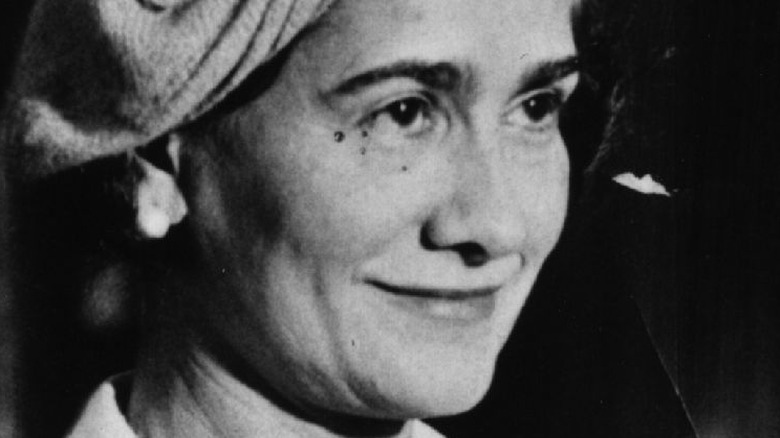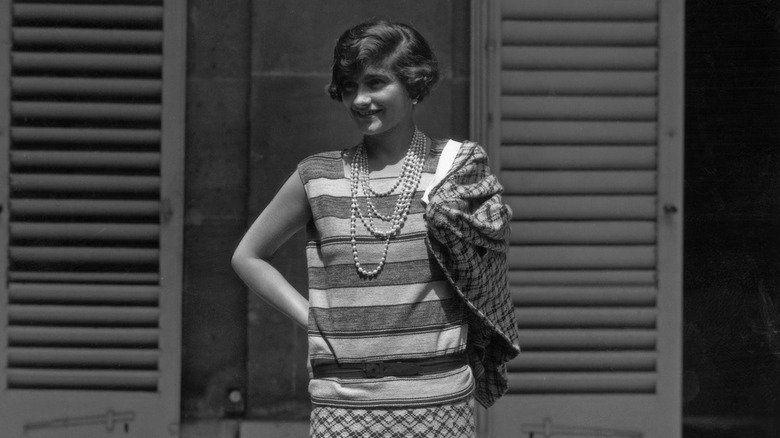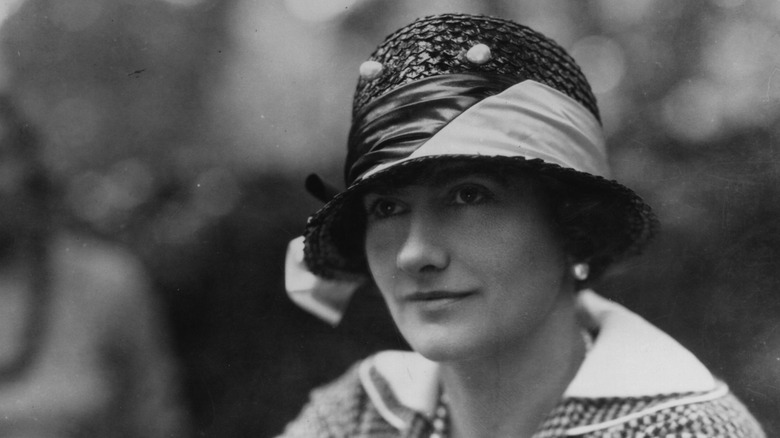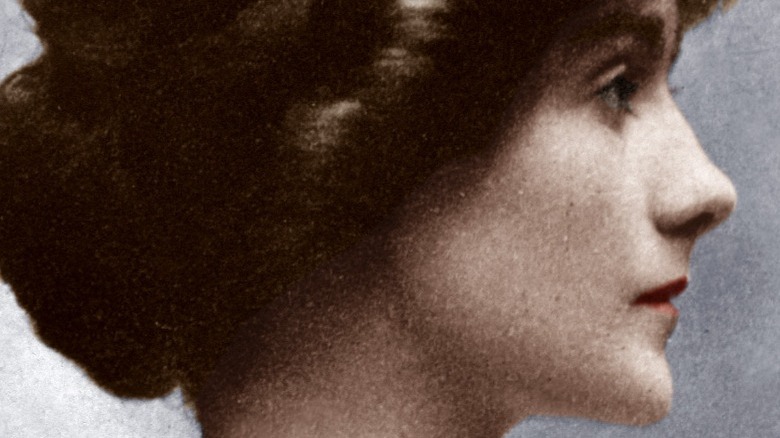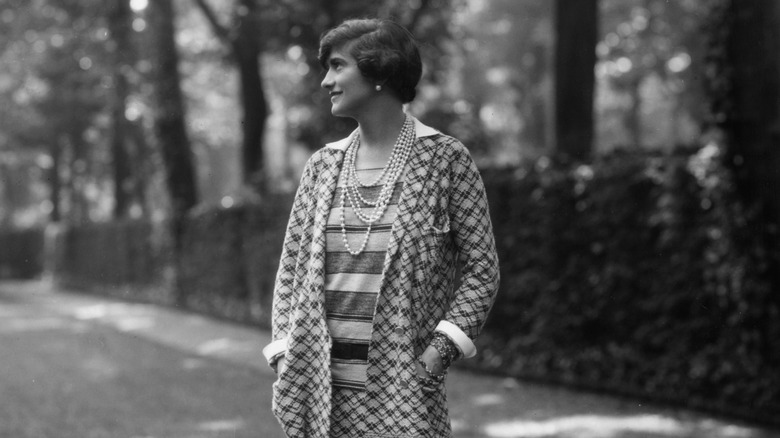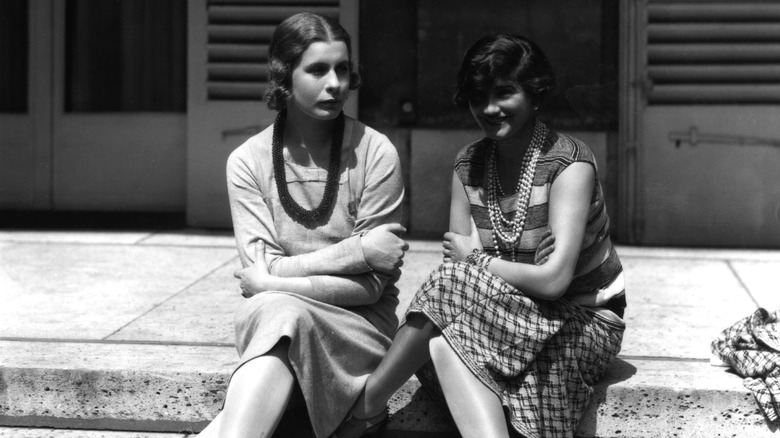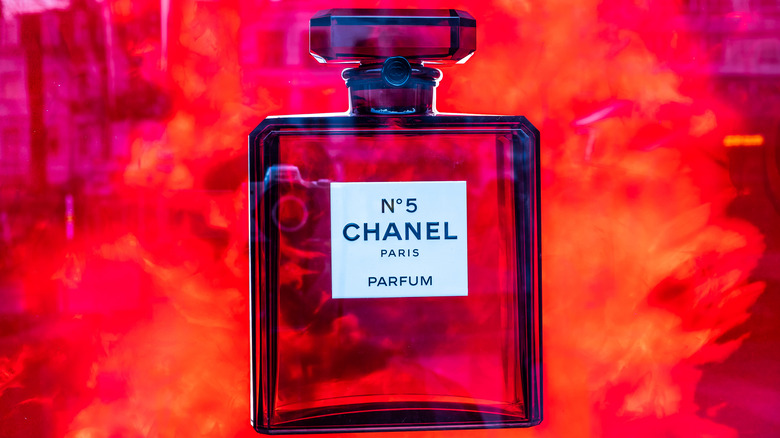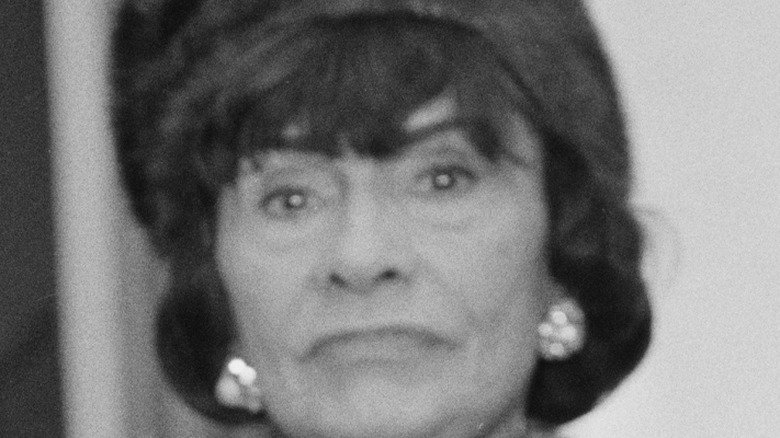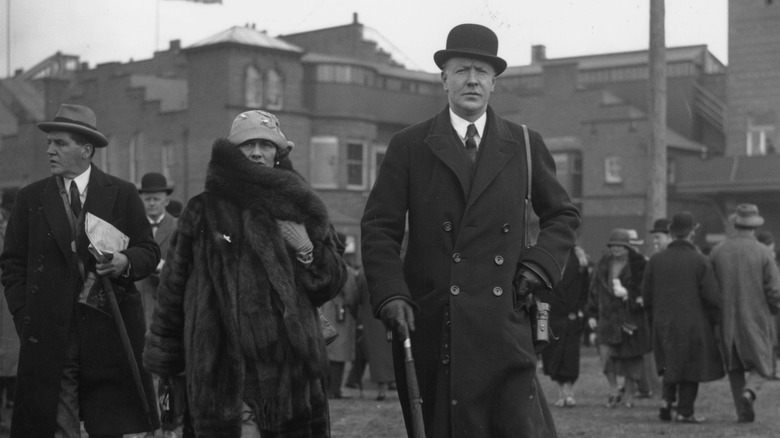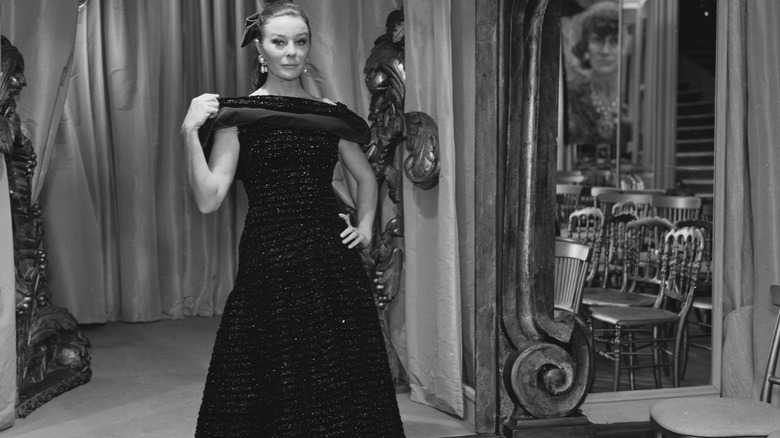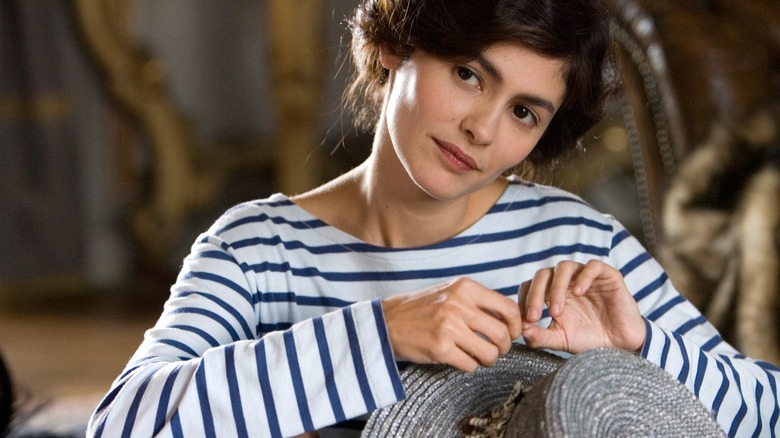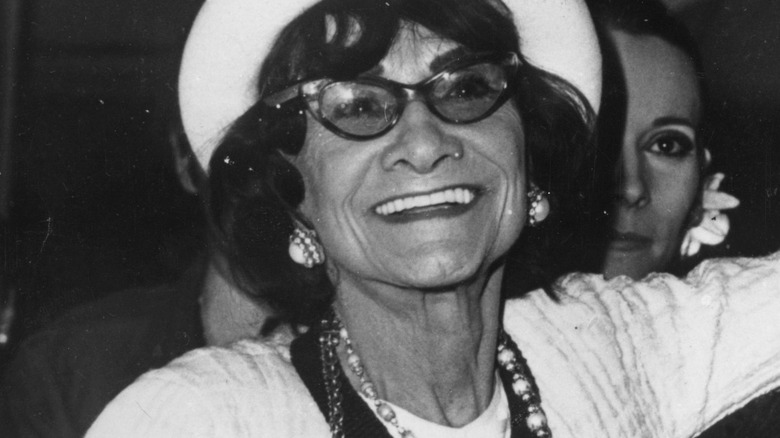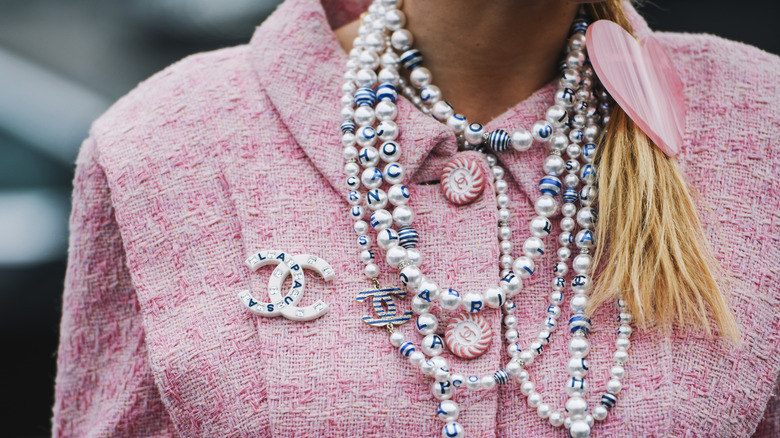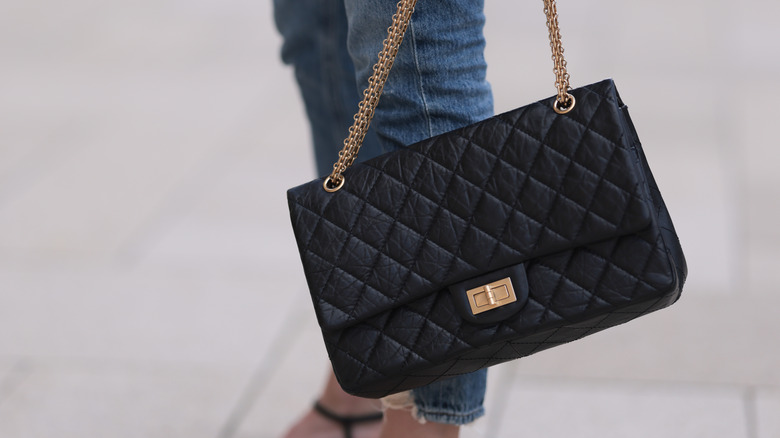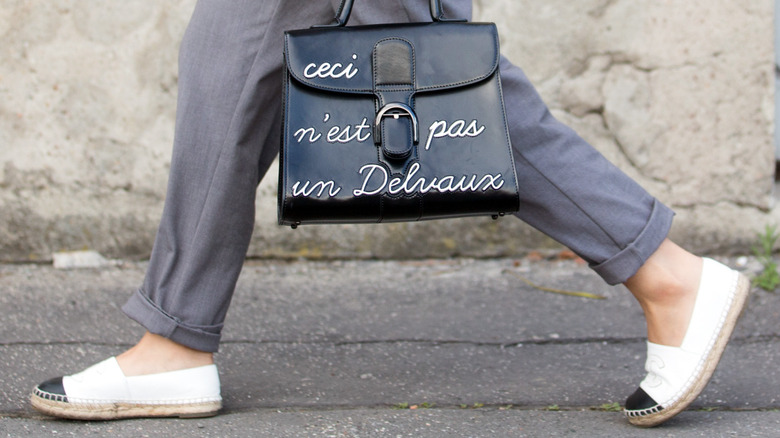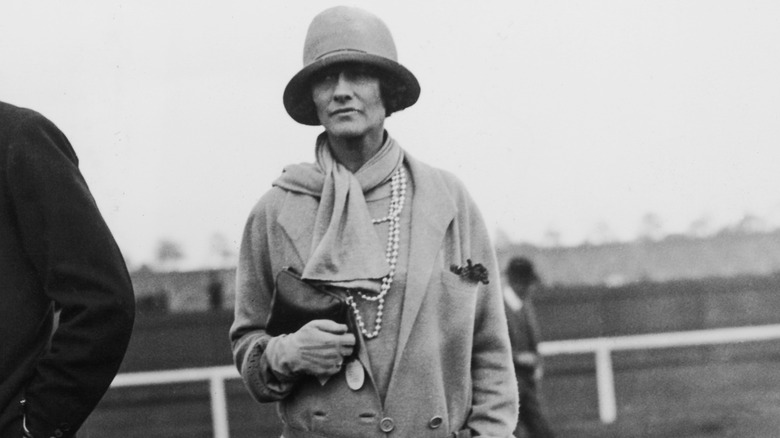How Coco Chanel Changed The World Of Fashion
When you hear the name Coco Chanel, a few specific images probably come to mind. Maybe it's the instantly recognizable logo of two Cs linked together. Perhaps it's a bottle of the legendary Chanel No. 5 perfume. Maybe it's the iconic black quilted crossbody bag that has become a staple of the fashion world. Maybe it's Jackie Onassis in that famous Chanel pink suit. Or maybe it's Marge Simpson in that same suit. Whatever your associations with Chanel may be, it's hard to deny the impact and prevalence of Chanel in the fashion world.
It has been just over a century since Chanel made her mark in the industry with a tiny shop. Now, her name is synonymous with French simplicity and chicness. So, how did Chanel go from being a poor girl in rural France to one of the biggest names in fashion? Here are all of the ways Chanel transformed the industry throughout her career.
Coco Chanel grew up poor
Gabrielle "Coco" Chanel was undoubtedly not her generation's version of a nepotism baby. She was born in 1883 to unmarried parents. Her father sold work clothing and hopped from town to town without any real home. Chanel was raised in a Catholic convent orphanage after her mother's death when she was 11.
While you might not imagine that growing up in a convent would set you up for a career in fashion, Chanel's impoverished upbringing directly affected her future. It was at the convent that she learned to sew (via Headspace).
Chanel's childhood also gave her surprising inspiration for her future designs. As one nun from the convent told Tatler Asia, "Celestial motifs, especially that [five-pointed] star [in the mosaic tiles], repeatedly appear in Chanel jewelry designs, and five became her lucky number, hence Chanel No 5 perfume." Chanel was also reportedly inspired by the black and white clothing of the nuns and the beige convent walls for her future minimalist signature color scheme.
She took on a series of odd jobs before dating a string of wealthy men
After leaving the convent at 18, Coco Chanel began to scrape together a living with a series of odd jobs. According to L'Officiel, she worked as a sales assistant in the Maison Grampayre shop during the day while singing in a cafe in the evenings. Her signature song, "Qui qu'a vu Coco?" eventually led to her famous nickname.
Once again, these inauspicious beginnings were an important building block in her future career in fashion. Thanks to the cafe, Chanel began to meet fashion executives and started moving in the right circles. One executive was Étienne de Balsan, with whom she had a six-year relationship. While living with de Balsan, Chanel soon became famed for her designs, as her hats were popular among several famous French actresses (via Chanel). With de Balsan's financial help, she eventually opened her first shop in Deauville in 1913.
Coco Chanel opened shops in 1912 and 1915 that revolutionized fashion
With her first shop in 1912, Coco Chanel first put herself on the fashion world's map for the first time. Her new shop didn't just sell hats, but sportswear made of jersey. As the Chanel website noted, this was the first time jersey had been used in sports clothing for women — and, of course, it's still used to this day.
As Chanel's fame grew, she expanded her business to include a couture shop in Biarritz in 1915. With a new staff of 300, Chanel produced her first Haute Couture collection that year. Her collection was a success. As The Voice of Fashion explained, Chanel filled a gap in the market as her simple, modern designs were perfect for women during the First World War, many of whom were volunteering and working more than ever before. Chanel catered to the contemporary woman and helped to move fashion past the corsetry and layers of the 1800s and into the 20th century.
Her poor girl look became a sought after trend
Although Coco Chanel's design changed as the years went by, her signature style was simple and relatively unadorned. She is famously quoted as saying, "Simplicity is the keynote of all true elegance" (via Harper's Bazaar).
So, where did this dedication to simplicity come from? Many believe her chic, simple style stemmed from her childhood. As Time reported in 1957, she "invented the genre pauvre or poor look." Her signature looks included simple, functional clothing like slack dresses and backless shoes, while her designs were inspired by mechanics' and waitresses' uniforms. In fact, she helped to transform the idea that wealth was equivalent to style. As Chanel herself put it, "Some people think luxury is the contrary of being poor. No, it is the contrary of vulgarity."
The "poor look" is still prevalent in fashion today. As a 2018 Spectator piece proclaimed, "Popular fashion is now marketing shoes and clothing that makes you look poor." Well, it seems that this trend is nothing new — in fact, it goes all the way back to Chanel.
She became one of the most famous designers of the Flapper era
As the 1920s hit their full swing, Coco Chanel was perfectly placed to deliver groundbreaking new looks for women of the era. After rising to fame with her modern World War I fashions, by the time of the Flapper, she was already a leading figure in the fashion world.
As Marie Claire noted, Chanel was directly responsible for many of the iconic Flapper looks that first appeared in the 1920s, including the iconic androgynous flat-chested, dropped waist silhouette that became the signature style of the era.
She was also responsible for introducing trousers into women's fashion. As CNN reported, women had started to wear trousers during the First World War as they undertook "male" jobs. However, until Chanel came along, they weren't considered fashionable. Chanel introduced the flowy beach trousers look in 1918 — she called them "beach pajamas." Soon, everyone was wearing them. In fact, the "beach pajama" look is still popular today (via Cosmopolitan).
In 1921, Coco Chanel teamed up with Ernest Beaux for perfumes
While Coco Chanel was obviously an instrumental player in the history of clothing, she also made huge contributions to the history of scent. In 1921, she launched her first perfume — the iconic No 5. The perfume was a collaboration with perfumer Ernest Beaux.
The perfume itself was different from women's fragrances that had come before. Chanel reportedly asked Beaux to create a scent that would "smell like a woman, not like a rose." The result was a perfume that people described as "mature" and sophisticated. Chanel herself became a lifelong devotee, saying it "was what I was waiting for...a woman's perfume, with the scent of a woman" (via History).
Not only did No. 5 set a new bar for women's fragrances, but it also became a legendary perfume. Marilyn Monroe famously said she went to bed wearing nothing but "a few drops of Chanel No. 5" (via the New York Post), while celebrities like Victoria Beckham, Eva Mendes, Nicole Kidman, Jessica Alba, and Celine Dion are all allegedly fans (via Who What Wear). As of 2020, it remained the world's most popular perfume (via Lifestyle Asia).
She took her business partner to court
As Coco Chanel's business grew and grew, the designer began to realize that she wasn't entirely in control of her own work. As Funding Universe reported, when Chanel first launched her perfume empire, she made a deal with financier Pierre Wertheimer. Wertheimer would go on to fund the perfume collection, but he would also retain 70% ownership of the company. Chanel would own only 10%, while another partner, Theophile Bader, was the recipient of 20%.
Eventually, Chanel realized that she wasn't exactly getting the best deal. So, she decided to launch a series of lawsuits against her partner in order to try to carve back some of her empire (via The New York Times Magazine). Her legal battles unfortunately never panned out, and the Wertheimer family now owns 100% of the Chanel brand, as well as the name itself (via Financial Review).
Coco Chanel lived in London while having an affair with Edward, the Prince of Wales
In 1923, Coco Chanel was introduced to Hugh Richard Arthur Grosvenor, the Duke of Westminster, who later abdicated the throne upon the death of his father, King George V. Chanel and Edward launched into a 10-year-long relationship, with Chanel even living with Edward in England for several years.
This allowed Chanel to introduce her French fashions to a new British audience (via PBS). According to the Evening Standard, she launched a business in London's Mayfair. Some people even believe that the Duke was so infatuated he put her fashion house's logo on every lamppost in Westminster.
It's clear that Chanel began to have a significant impact on British fashion at this time, thanks to her affair. After living in London, her revolutionary fashions began to take over in the U.K. as well as in France.
She created the little black dress
One of Coco Chanel's most significant contributions to the fashion world was the little black dress — that's right, Chanel was responsible for our go-to chic going-out dress. While the LBD has a long and vibrant history from Audrey Hepburn in "Breakfast at Tiffany's" to Princess Diana, it all began in 1926 when Vogue published a sketch by Chanel of a little black dress called "Chanel's Ford." According to Marie Claire, the magazine wrote, it was going to be "a sort of uniform for all women of taste."
While the LBD has become a staple of every woman's wardrobe, at the time, it was revolutionary. As ABC noted, black had previously been a color for mourning. At the time, many women were wearing black after the First World War and the Spanish flu. So, Chanel created a chic, modern version of the mourning dress for women of the era.
She started the French-girl nautical top trend
Another classic fashion trend that Coco Chanel gave us is the chic striped nautical top, also known as the Breton top, maniere, or the sailor top. The pinnacle of French girl style, the top features a white and blue color scheme and wide-set horizontal stripes across the chest. The top was initially inspired by French naval outfits from the beginning of the 20th century.
Chanel included nautical stripes in her 1917 collection. She first introduced the striped sailor top into her own wardrobe while holidaying on the French Riviera in the 1920s, along with her masculine, wide-legged yachting trousers (via RMG). "She was the embodiment of Riviera chic in her Breton top, worn with simple jersey trousers, photographed at her villa, La Pausa, on the Riviera," Harper's Bazaar editor-in-chief Justine Picardie said.
Since Chanel popularized the style, it has remained a staple of every chic wardrobe. Over the years, a version of this classic top has been seen on the likes of James Dean, Pablo Picasso, Kate Moss, Alexa Chung, and Kate Middleton, to name just a few (via StyleCaster).
Coco Chanel introduced the world to costume jewelery
Coco Chanel was also way ahead of her time regarding accessories. At a time when most women wore very simple, delicate jewellery, Chanel broke with tradition and wore jewellery that was big and bold. Many people credit her with beginning the trend of costume jewelry.
As Female noted, Chanel often paired expensive jewelry pieces with cheap "costume" pieces. In the 1920s, she began designing costume-inspired jewelry as part of her collections. It was a direct contrast to her simple taste in clothing. As she once famously said, "Costume jewelry isn't made to provoke desire, just astonishment at most. It must remain an ornament and an amusement."
Some of her most famous designs included the 1927 Maltese cross and the 1954 "nest" earrings. Chanel even started the trend of wearing necklaces draped over the back rather than the front. Costume jewelry is still going strong to this day. According to Statista, by 2026, the industry will reach a value of 60 billion U.S. dollars.
Coco Chanel's famous suit became iconic
Coco Chanel is responsible for one of the most iconic outfits in history. Yes, we are talking about that famous pink suit. The suit is now perhaps best known as the outfit worn by Jackie Onassis on the day of John F. Kennedy's assassination. As L'Officiel noted, the suit became a symbol of Jackie's strength. The suit was eventually donated to archives and is now in storage.
But the Chanel suit's story began long before the 1960s. Chanel first began to use tweed in women's designs in the 1920s. By the 1950s, she had come up with her first iconic tweed suit jacket. As Marie Claire explained, the boxy, straight suit was a contrast to the popular hourglass silhouette made famous by Christian Dior in the '50s. Chanel's jacket was instantly recognizable thanks to the single seam on the back, the four pockets, and the trimmed edges.
Since Jackie wore the suit, numerous other celebrities have also donned the famous Chanel jacket, including Claudia Schiffer, Princess Diana, Scarlett Johansson, Victoria Beckham, Beyonce, Kate Middleton, and Kendall Jenner (via Vogue). There was even an entire episode of "The Simpsons" dedicated to the famous Chanel look.
She launched the game-changing 2.55 bag in 1955
Few handbags are better known than Coco Chanel's famous quilted 2.55. The flap bag first came to be in February 1955, hence the name. According to Lifestyle Asia, the bag was initially made to imitate military flap bags that emerged in the 1920s. Unlike most women's bags at the time, which were designed to be held by handles, the bag had a long strap. As Chanel once said, "I got fed up with holding my purses in my hands and losing them, so I added a strap and carried them over my shoulder."
According to Glamour, the famous chain strap was potentially inspired by the bridles of horses or by the belts that the nuns once wore at the convent where Chanel grew up. As for the quilted design, that is likely also a reference to the outfits worn by stable boys. As for the small front flap, rumor has it; it's for storing love letters.
To this day, celebrities still can't get enough of the 2.55. The likes of Alexa Chung, Rachel Bilson, Princess Diana, Jessica Alba, Hilary Duff, and Kim Kardashian have all been spotted with the bag.
She influenced the rise of the espadrille
It's clear that Coco Chanel's time on the French Riviera in the '20s and '30s had a significant impact on luxurious, laid-back holiday fashion as seen for generations going forward. Not only did she inspire the rise of "beach pants," but she also helped to popularize the espadrille sandal. As writer Simone de Beauvoir once wrote of Chanel, she would often wear merely "an old dress and espadrilles." Very French It-Girl behavior if you ask us. After Chanel started the espadrilles trend, her successor at the company, Karl Lagerfeld, reintroduced the sandals in the 2013 Chanel collection (via Vogue).
Over the years, Chanel espadrilles have become a staple of the chic woman. They were spotted on the likes of Audrey Hepburn and Lauren Bacall during the '40s and '50s. And today, celebrities like Kendall Jenner, Katie Holmes, and Alessandra Ambrosio have their own pairs.
Coco Chanel's affiliations with Nazis during WWII complicates her legacy
While Coco Chanel is typically considered a timeless fashion icon, her legacy isn't uncomplicated. During the Second World War, the designer shut down all but one of her shops and moved into the Ritz with her lover, Nazi officer Baron Hans Günther von Dincklage. In 1941, she registered as a German spy and traveled to Madrid to collect information for the German forces (via Biography).
Looking back at Chanel's legacy in the fashion world, it's impossible to untangle her Nazi connections. In fact, some experts believe her political history gives us some insight into her work. As Tansy Hoskins, author of "Stitched Up: The Anti-Capitalist Book of Fashion," told Forbes, "It's clear that Chanel's far-right ideologies influenced her designs. She championed minimalism and the austere. It's very white European."
However, a spokesperson for the brand said, "Her actions during World War II are the subject of discussion in many publications and biographies. The actions that some have reported in no way represent the values of Chanel today. Since that time in history, the House of Chanel has moved forward well beyond the past of its founder."
